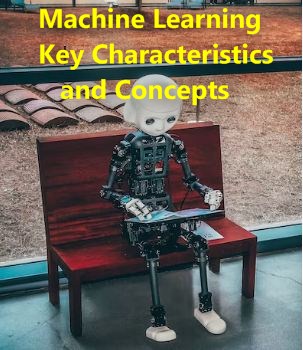Machine Learning Key Characteristics and Concepts –
Definition: Machine learning (ML) is a subset of artificial intelligence (AI) that focuses on the development of algorithms and models that allow computer systems to improve their performance on a specific task through learning from data, without being explicitly programmed.

Machine Learning Key Characteristics and Concepts –
In other words, instead of relying on explicit instructions, a machine learning system can learn and adapt from data to make predictions, decisions, and solve problems. Here are some key characteristics and concepts associated with machine learning:
- Learning from Data: Machine learning systems are designed to analyze and learn from data. They can identify patterns, relationships, and trends within datasets to make predictions or take actions.
- Data is Key: High-quality, relevant data is crucial for training and evaluating machine learning models. The quality and quantity of data play a significant role in the model’s performance.
- Types of Learning:
- Supervised Learning: In supervised learning, the model is trained on a labeled dataset, where the input data is paired with the correct output or target. The model learns to make predictions based on the input data and is evaluated on how well it predicts the correct outputs.
- Unsupervised Learning: Unsupervised learning involves finding patterns or structure in data without labeled outputs. Clustering and dimensionality reduction are common tasks in unsupervised learning.
- Reinforcement Learning: In reinforcement learning, an agent learns to make decisions by interacting with an environment. It receives rewards or penalties based on its actions and aims to maximize its cumulative reward over time.
- Feature Extraction: Feature extraction involves selecting and transforming relevant data attributes or features to use as input for machine learning algorithms. Good feature selection can significantly impact a model’s performance.
- Model Building: Machine learning algorithms and models are used to learn from data. Common algorithms include decision trees, support vector machines, neural networks, and more recently, deep learning models like convolutional neural networks (CNNs) and recurrent neural networks (RNNs).
- Generalization: A key goal of machine learning is to create models that can generalize their learned knowledge to make predictions or decisions on new, unseen data. Overfitting (model fitting the training data too closely) and underfitting (model oversimplification) are common challenges in achieving good generalization.
- Applications: Machine learning has a wide range of applications, including image and speech recognition, natural language processing, recommendation systems, autonomous vehicles, fraud detection, and medical diagnosis, among others.
- Continuous Learning: Machine learning models can be updated and adapted to new data, allowing systems to improve over time and stay relevant.
Machine learning has become a powerful tool in various fields, providing solutions to complex problems that were once challenging to tackle with traditional programming methods. It continues to advance and evolve, with ongoing research and development in both algorithms and applications.
![]()